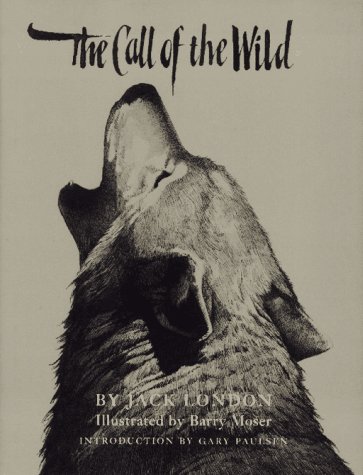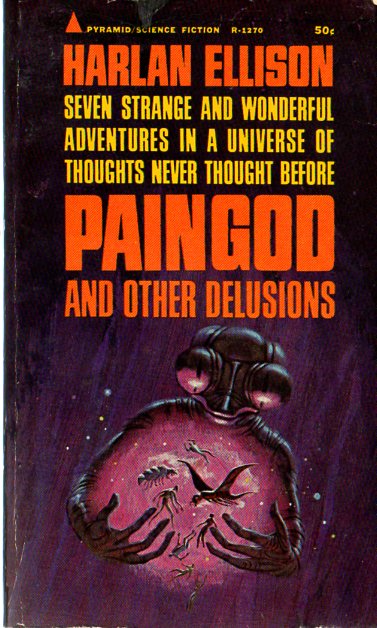 Jack London wrote two books about wolves, and they are the mirror image of each other. White Fang is about a wild animal becoming tame, Call of the Wild is about a tame animal becoming wild.
Jack London wrote two books about wolves, and they are the mirror image of each other. White Fang is about a wild animal becoming tame, Call of the Wild is about a tame animal becoming wild.
Both books are excellent to the point where they are hazardous to have lying around the house. To this day if I see either White Fang or Call of the Wild, I drop what I’m doing, pick it up, and then read through ten or fifty or a hundred pages, caught up once more in the story. These books are hijackers of the brain, and obviously I now keep them far from view.
White Fang is longer and more elaborate, but Call of the Wild is better. It’s spare and lean, like the animals in it, and is paced faster than a modern thriller novel. It’s about a dog named Buck. His upbringing is described in a few pages. Through a stroke of ill fortune, he has found himself on a train bound for the Klondike gold rush, where they need strong dogs with thick coats. Buck’s new home is inhospitable, and it seems he must survive or die. He ends up doing a third thing: transcend.
Books and movies about animals tend to raise public interest in owning said animal as a pet. When Balto come out, children pestered their parents for a pet husky, and no doubt a few unwitting people signed on to become owners of an energetic, destructive animal that needs constant attention and exercise. I don’t think this book would contribute to that problem. Although Jack London often depicts wolves and dogs as noble and romantic, he shows their unpleasant side too. Lex talionis is the order of the day here. Buck is nominally part of a team, but status is everything and he must always be on guard against a sledmate’s fangs in his flank.
There’s not a boring page in the book, from the battles with arch-rival Spitz to mesmerising journeys into the unknown to humorous scenes involving humans. At some point Buck and his team are sold to a trio of comically inept Southerners. Well, it’s only comical at the beginning. Soon dogs start dying under their care, and the laughs stop coming.
Although his creatures are anthropomorphised to a degree, London had a talent in invoking one’s sympathy for animals. The dog Dave is a great example. I was always amazed that London could make me emotionally involved in his plight of a character that doesn’t get a line of dialogue, and only a single identifiable trait (he’s a bit like Boxer in Orwell’s Animal Farm).
The events of the final few pages happen in a blur, and then Buck embraces his destiny. His fate may not seem realistic, but that may be our pitiful prefrontal cortexes talking. Call of the Wild is a book about the deceptiveness of evolution. There’s no “advanced” or “less advanced” in the natural kingdom, and our civilisation just represents a series of adaptations that have proven useful in certain circumstances. Buck adapts in a totally different direction: his environment calls for him to become a primitive creature, and so he becomes a primitive creature. No human in reality or fiction could do what Buck does. We just aren’t wild enough.
No Comments »
 Let’s just say it, Harlan Ellison is not the finest specimen the human race has produced. He probably wouldn’t be in the top 10, either. Ordinarily I’d just ignore his personality and read his stories, like I try to do with everyone else. Three rules for happiness and inner peace: don’t research the personal life of your favourite author, don’t research the meaning of your favourite song, and don’t read the ingredients on your favourite prepackaged snack.
Let’s just say it, Harlan Ellison is not the finest specimen the human race has produced. He probably wouldn’t be in the top 10, either. Ordinarily I’d just ignore his personality and read his stories, like I try to do with everyone else. Three rules for happiness and inner peace: don’t research the personal life of your favourite author, don’t research the meaning of your favourite song, and don’t read the ingredients on your favourite prepackaged snack.
But Ellison makes it difficult, because his egomaniac personality intrudes into the books. You get the impression that he doesn’t enjoy telling stories so much as he enjoys being a man who tells stories. He opens the book with two introductions, and then a foreword for each of the eight stories. Ellison interrupts your reading experience to talk about himself ten times. Nobody give this man a Broadway show, or he’ll spend three hours taking bows under the stage lights.
The quality of the stories is a bit up and down, although mostly up. “Paingod” is not a great story, but it is an interesting one. It’s about a godlike being called Trente whose sole purpose is to apportion and distribute suffering throughout the universe. Spending your life making people unhappy is not good for one’s self esteem, and there’s a lot of navel-gazing philosophy, and rumination on things like duty and obedience.
“‘Repent, Harlequin!’ Said the Ticktockman” is an industrious packmule of a story, carrying a lot of ideas and themes despite its short length. It sports one of fiction’s odder revolutionaries: a perpetual slacker in a world where the greatest crime is to be late. Ellison writes the hell out of this one. I was sad when it was over.
“Sleeping Dogs” is about a government intermediary having to work with a shoot-first-ask-questions-never general who has just committed genocide on an alien world. Ellison lays on the melodrama pretty thick, and the effect is over the top. Ellison seems concerned that we don’t get the point, and he repeats it so many times that soon we don’t want to get the point.
“Deeper than Darkness” is King’s Firestarter written 15 years before. A lonely drifter can create fires with his mind, and earns the interest of government spooks looking to use him as a weapon. Another story with sad violins playing throughout, but I like it more than “Sleeping Dogs.”
Ellison’s short stories are consistently better than his longer works, and his short short stories are better than his longer short stories. I come to this impression from this volume and the few others I’ve read: that he’s at his best when he keeps things brief. Sometimes the longer he goes, the less he says.
But it seems to be quite rare for Ellison to write something that’s a complete waste of time. Even his worst works seem like good ideas marred by horrible writing or stupid decisions, not irredeemable trash. I don’t really get an inner “why does this exist?” reaction from many of Ellison’s stories, and that’s certainly impressive.
No Comments »
 Adventures of Dino-Riki is a NES game similar to nearly every other NES game. It’s a top-down shooter set in prehistoric times that has you killing dinosaurs. How come nobody ever tweaks the formula? Is there a game where you have a stack of adrenaline hypos, and you bring dead monsters back to life by shooting them?
Adventures of Dino-Riki is a NES game similar to nearly every other NES game. It’s a top-down shooter set in prehistoric times that has you killing dinosaurs. How come nobody ever tweaks the formula? Is there a game where you have a stack of adrenaline hypos, and you bring dead monsters back to life by shooting them?
This game is hard. 80s hard. You can only have so much game on a NES cart, so developers compensated by designing games that killed you like their name is Inigo Montoya. Die, restart, die, restart. That’s how you stretch out half an hour of gameplay.
The game’s punishing difficulty is exacerbated by various lovely design decisions. You lose all your weapons and powerups when you die. And the screen scrolls upwards at a constant rate, so timing a jump requires you to carefully calculate your forward momentum plus the scroll rate. I’m pretty sure the Iraqi Royal Guard used this game to train soldiers to aim Scud missiles.
My enthusiasm for The Adventures of Dino-Riki is just flowing off the page, so the question remains: why did I play it? And why do I remember it?
Well, it has some positive qualities. For one (and this is huge) it’s not set in space. Instead of boring starry backgrounds you get actual things to look at. Trees. Bushes. Grass. It’s wonderful.
And the “real life” setting means you can apply logic to it in a way that you usually can’t for. If you fall down a hole, you die. You aren’t getting attacked by random phallic shapes but by recognisable creatures. Certain things make immediate logical sense. If you fall into a hole, you die. To compare, it was never clear to me why some objects in Star Force killed me while others didn’t. The controls in Dino-Riki feel tight and responsive (mostly, fuck you if you’re trying to fly). Some things take getting used to, such as the screen scrolling forward at a certain rate, but get used to it you will. The boss fights are awesome. Laying down an extinction level event on a T-rex is fun no matter the game, whether it’s Turok or Tomb Raider or this one.
In short, Adventures is a typical Hudson Soft game. Screamingly unoriginal, and it charms and frustrates in equal measure. There’s moments where the game comes together and it becomes fun, then there’s all these moronic, inexplicable ideas that serve no purpose other than to cultivate in you a deep dislike of the game industry. How come your shots are blocked by vegetation, while enemies can shoot you through anything? How come you have to hold down the X button constantly to fly (even though you might be in the air for as long as five minutes?) How come your character has the faggiest death animation in documented history? He looks like he’s having a seizure.
Oh yeah, and can we talk about death animations.
Nintendo game developers. How do you depict death, given
- Nintendo’s famous censorship
- Terrible graphics
Platform games just have you fall off the screen. Vertical scrollers just have you blow up. But Dino Riki. They end up .
You could never call Dino Rikki a classic, and as far as I’m concerned it barely makes it to “decent game” status. Despite this, I can’t bash it too much. The NES catalogue is a refuse bin of horrible games and this one is actually fairly decent.
No Comments »
 Jack London wrote two books about wolves, and they are the mirror image of each other. White Fang is about a wild animal becoming tame, Call of the Wild is about a tame animal becoming wild.
Jack London wrote two books about wolves, and they are the mirror image of each other. White Fang is about a wild animal becoming tame, Call of the Wild is about a tame animal becoming wild.

